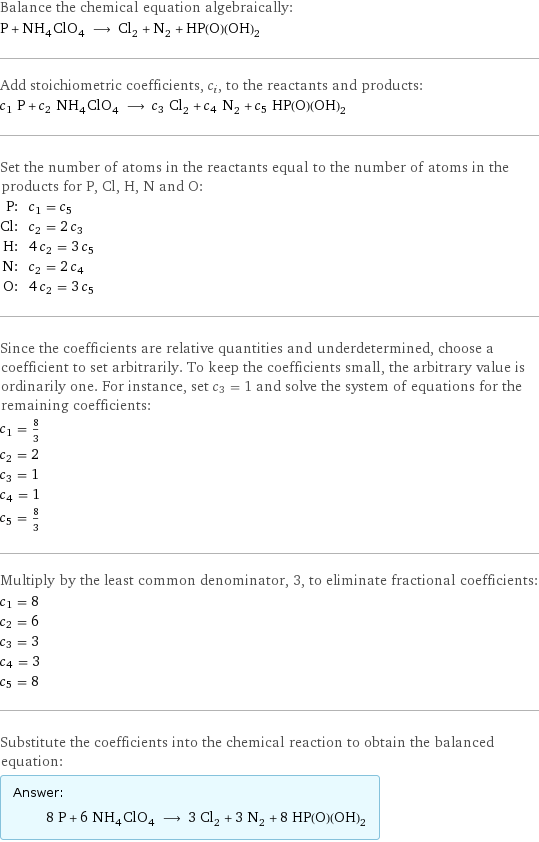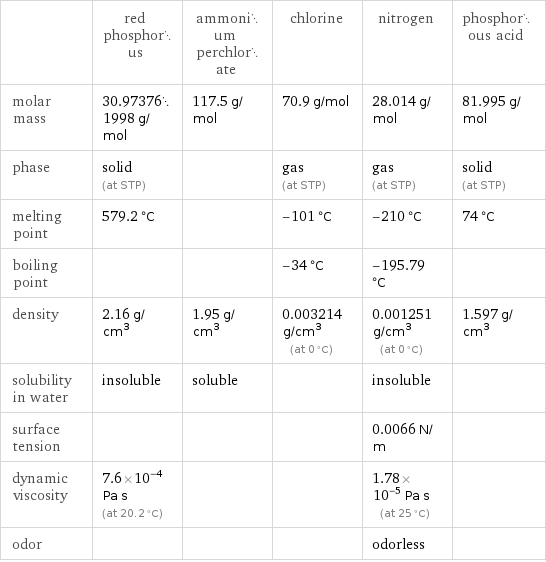Input interpretation

P red phosphorus + NH_4ClO_4 ammonium perchlorate ⟶ Cl_2 chlorine + N_2 nitrogen + HP(O)(OH)_2 phosphorous acid
Balanced equation

Balance the chemical equation algebraically: P + NH_4ClO_4 ⟶ Cl_2 + N_2 + HP(O)(OH)_2 Add stoichiometric coefficients, c_i, to the reactants and products: c_1 P + c_2 NH_4ClO_4 ⟶ c_3 Cl_2 + c_4 N_2 + c_5 HP(O)(OH)_2 Set the number of atoms in the reactants equal to the number of atoms in the products for P, Cl, H, N and O: P: | c_1 = c_5 Cl: | c_2 = 2 c_3 H: | 4 c_2 = 3 c_5 N: | c_2 = 2 c_4 O: | 4 c_2 = 3 c_5 Since the coefficients are relative quantities and underdetermined, choose a coefficient to set arbitrarily. To keep the coefficients small, the arbitrary value is ordinarily one. For instance, set c_3 = 1 and solve the system of equations for the remaining coefficients: c_1 = 8/3 c_2 = 2 c_3 = 1 c_4 = 1 c_5 = 8/3 Multiply by the least common denominator, 3, to eliminate fractional coefficients: c_1 = 8 c_2 = 6 c_3 = 3 c_4 = 3 c_5 = 8 Substitute the coefficients into the chemical reaction to obtain the balanced equation: Answer: | | 8 P + 6 NH_4ClO_4 ⟶ 3 Cl_2 + 3 N_2 + 8 HP(O)(OH)_2
Structures

+ ⟶ + +
Names

red phosphorus + ammonium perchlorate ⟶ chlorine + nitrogen + phosphorous acid
Equilibrium constant
![Construct the equilibrium constant, K, expression for: P + NH_4ClO_4 ⟶ Cl_2 + N_2 + HP(O)(OH)_2 Plan: • Balance the chemical equation. • Determine the stoichiometric numbers. • Assemble the activity expression for each chemical species. • Use the activity expressions to build the equilibrium constant expression. Write the balanced chemical equation: 8 P + 6 NH_4ClO_4 ⟶ 3 Cl_2 + 3 N_2 + 8 HP(O)(OH)_2 Assign stoichiometric numbers, ν_i, using the stoichiometric coefficients, c_i, from the balanced chemical equation in the following manner: ν_i = -c_i for reactants and ν_i = c_i for products: chemical species | c_i | ν_i P | 8 | -8 NH_4ClO_4 | 6 | -6 Cl_2 | 3 | 3 N_2 | 3 | 3 HP(O)(OH)_2 | 8 | 8 Assemble the activity expressions accounting for the state of matter and ν_i: chemical species | c_i | ν_i | activity expression P | 8 | -8 | ([P])^(-8) NH_4ClO_4 | 6 | -6 | ([NH4ClO4])^(-6) Cl_2 | 3 | 3 | ([Cl2])^3 N_2 | 3 | 3 | ([N2])^3 HP(O)(OH)_2 | 8 | 8 | ([HP(O)(OH)2])^8 The equilibrium constant symbol in the concentration basis is: K_c Mulitply the activity expressions to arrive at the K_c expression: Answer: | | K_c = ([P])^(-8) ([NH4ClO4])^(-6) ([Cl2])^3 ([N2])^3 ([HP(O)(OH)2])^8 = (([Cl2])^3 ([N2])^3 ([HP(O)(OH)2])^8)/(([P])^8 ([NH4ClO4])^6)](../image_source/42a74bc3527b9bc11a612f15dce1a2d8.png)
Construct the equilibrium constant, K, expression for: P + NH_4ClO_4 ⟶ Cl_2 + N_2 + HP(O)(OH)_2 Plan: • Balance the chemical equation. • Determine the stoichiometric numbers. • Assemble the activity expression for each chemical species. • Use the activity expressions to build the equilibrium constant expression. Write the balanced chemical equation: 8 P + 6 NH_4ClO_4 ⟶ 3 Cl_2 + 3 N_2 + 8 HP(O)(OH)_2 Assign stoichiometric numbers, ν_i, using the stoichiometric coefficients, c_i, from the balanced chemical equation in the following manner: ν_i = -c_i for reactants and ν_i = c_i for products: chemical species | c_i | ν_i P | 8 | -8 NH_4ClO_4 | 6 | -6 Cl_2 | 3 | 3 N_2 | 3 | 3 HP(O)(OH)_2 | 8 | 8 Assemble the activity expressions accounting for the state of matter and ν_i: chemical species | c_i | ν_i | activity expression P | 8 | -8 | ([P])^(-8) NH_4ClO_4 | 6 | -6 | ([NH4ClO4])^(-6) Cl_2 | 3 | 3 | ([Cl2])^3 N_2 | 3 | 3 | ([N2])^3 HP(O)(OH)_2 | 8 | 8 | ([HP(O)(OH)2])^8 The equilibrium constant symbol in the concentration basis is: K_c Mulitply the activity expressions to arrive at the K_c expression: Answer: | | K_c = ([P])^(-8) ([NH4ClO4])^(-6) ([Cl2])^3 ([N2])^3 ([HP(O)(OH)2])^8 = (([Cl2])^3 ([N2])^3 ([HP(O)(OH)2])^8)/(([P])^8 ([NH4ClO4])^6)
Rate of reaction
![Construct the rate of reaction expression for: P + NH_4ClO_4 ⟶ Cl_2 + N_2 + HP(O)(OH)_2 Plan: • Balance the chemical equation. • Determine the stoichiometric numbers. • Assemble the rate term for each chemical species. • Write the rate of reaction expression. Write the balanced chemical equation: 8 P + 6 NH_4ClO_4 ⟶ 3 Cl_2 + 3 N_2 + 8 HP(O)(OH)_2 Assign stoichiometric numbers, ν_i, using the stoichiometric coefficients, c_i, from the balanced chemical equation in the following manner: ν_i = -c_i for reactants and ν_i = c_i for products: chemical species | c_i | ν_i P | 8 | -8 NH_4ClO_4 | 6 | -6 Cl_2 | 3 | 3 N_2 | 3 | 3 HP(O)(OH)_2 | 8 | 8 The rate term for each chemical species, B_i, is 1/ν_i(Δ[B_i])/(Δt) where [B_i] is the amount concentration and t is time: chemical species | c_i | ν_i | rate term P | 8 | -8 | -1/8 (Δ[P])/(Δt) NH_4ClO_4 | 6 | -6 | -1/6 (Δ[NH4ClO4])/(Δt) Cl_2 | 3 | 3 | 1/3 (Δ[Cl2])/(Δt) N_2 | 3 | 3 | 1/3 (Δ[N2])/(Δt) HP(O)(OH)_2 | 8 | 8 | 1/8 (Δ[HP(O)(OH)2])/(Δt) (for infinitesimal rate of change, replace Δ with d) Set the rate terms equal to each other to arrive at the rate expression: Answer: | | rate = -1/8 (Δ[P])/(Δt) = -1/6 (Δ[NH4ClO4])/(Δt) = 1/3 (Δ[Cl2])/(Δt) = 1/3 (Δ[N2])/(Δt) = 1/8 (Δ[HP(O)(OH)2])/(Δt) (assuming constant volume and no accumulation of intermediates or side products)](../image_source/5d8f21f1ae7734b9789c35fc358676c6.png)
Construct the rate of reaction expression for: P + NH_4ClO_4 ⟶ Cl_2 + N_2 + HP(O)(OH)_2 Plan: • Balance the chemical equation. • Determine the stoichiometric numbers. • Assemble the rate term for each chemical species. • Write the rate of reaction expression. Write the balanced chemical equation: 8 P + 6 NH_4ClO_4 ⟶ 3 Cl_2 + 3 N_2 + 8 HP(O)(OH)_2 Assign stoichiometric numbers, ν_i, using the stoichiometric coefficients, c_i, from the balanced chemical equation in the following manner: ν_i = -c_i for reactants and ν_i = c_i for products: chemical species | c_i | ν_i P | 8 | -8 NH_4ClO_4 | 6 | -6 Cl_2 | 3 | 3 N_2 | 3 | 3 HP(O)(OH)_2 | 8 | 8 The rate term for each chemical species, B_i, is 1/ν_i(Δ[B_i])/(Δt) where [B_i] is the amount concentration and t is time: chemical species | c_i | ν_i | rate term P | 8 | -8 | -1/8 (Δ[P])/(Δt) NH_4ClO_4 | 6 | -6 | -1/6 (Δ[NH4ClO4])/(Δt) Cl_2 | 3 | 3 | 1/3 (Δ[Cl2])/(Δt) N_2 | 3 | 3 | 1/3 (Δ[N2])/(Δt) HP(O)(OH)_2 | 8 | 8 | 1/8 (Δ[HP(O)(OH)2])/(Δt) (for infinitesimal rate of change, replace Δ with d) Set the rate terms equal to each other to arrive at the rate expression: Answer: | | rate = -1/8 (Δ[P])/(Δt) = -1/6 (Δ[NH4ClO4])/(Δt) = 1/3 (Δ[Cl2])/(Δt) = 1/3 (Δ[N2])/(Δt) = 1/8 (Δ[HP(O)(OH)2])/(Δt) (assuming constant volume and no accumulation of intermediates or side products)
Chemical names and formulas

| red phosphorus | ammonium perchlorate | chlorine | nitrogen | phosphorous acid formula | P | NH_4ClO_4 | Cl_2 | N_2 | HP(O)(OH)_2 Hill formula | P | ClH_4NO_4 | Cl_2 | N_2 | H_3O_3P name | red phosphorus | ammonium perchlorate | chlorine | nitrogen | phosphorous acid IUPAC name | phosphorus | | molecular chlorine | molecular nitrogen | phosphorous acid
Substance properties

| red phosphorus | ammonium perchlorate | chlorine | nitrogen | phosphorous acid molar mass | 30.973761998 g/mol | 117.5 g/mol | 70.9 g/mol | 28.014 g/mol | 81.995 g/mol phase | solid (at STP) | | gas (at STP) | gas (at STP) | solid (at STP) melting point | 579.2 °C | | -101 °C | -210 °C | 74 °C boiling point | | | -34 °C | -195.79 °C | density | 2.16 g/cm^3 | 1.95 g/cm^3 | 0.003214 g/cm^3 (at 0 °C) | 0.001251 g/cm^3 (at 0 °C) | 1.597 g/cm^3 solubility in water | insoluble | soluble | | insoluble | surface tension | | | | 0.0066 N/m | dynamic viscosity | 7.6×10^-4 Pa s (at 20.2 °C) | | | 1.78×10^-5 Pa s (at 25 °C) | odor | | | | odorless |
Units
